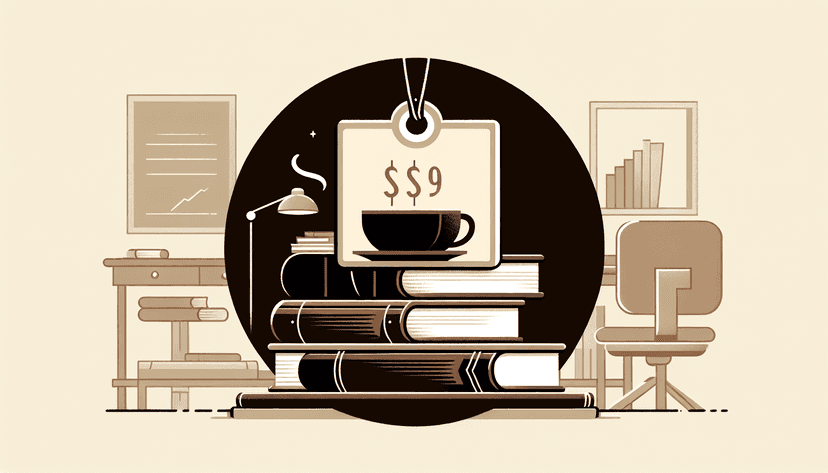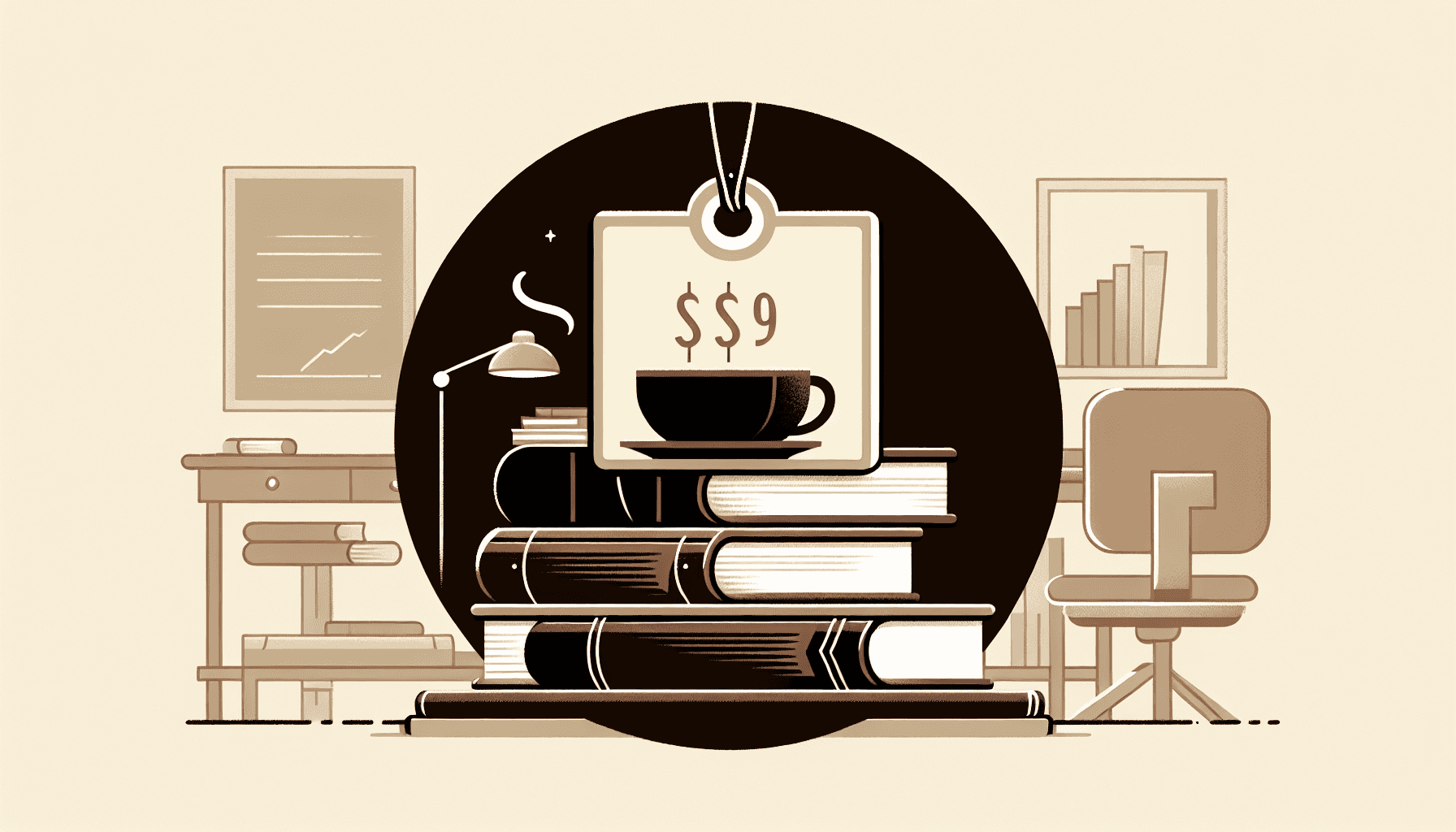Table of Contents
Setting the right price for your book can feel like navigating a minefield. You want to attract readers without undervaluing your hard work. It’s a common struggle for indie authors trying to find that sweet spot where sales meet satisfaction.
But don’t worry! If you stick around, I’ll share essential pricing strategies that can help you not just survive but thrive in the world of self-publishing. With the right approach, you’ll learn how to set prices that entice readers while reflecting your book’s true worth.
We’ll cover everything from understanding your audience to leveraging pricing psychology, and you’ll be equipped with the tools to make smart pricing decisions that support your writing career. Let’s dive in!
Key Takeaways
- Understand your audience’s price expectations within your genre to set a competitive price.
- Research competitors’ prices to identify market trends and find optimal pricing.
- Choose the right pricing model—low-entry for readership growth or higher for perceived quality.
- Set a competitive launch price to attract initial readers and build momentum.
- Adjust prices based on sales data and competitor movements to maximize profits.
- Use discounts and promotions effectively to engage new and existing readers.
- Leverage pricing psychology to make your book appear more affordable.
- Experiment with different price points to find what works best for your audience.
- Stay updated on market trends and adjust your pricing accordingly.
- Build reader loyalty through engagement, as a loyal audience drives long-term success.

1. Understand Your Audience for Book Pricing
Knowing your audience is crucial when setting a price for your book. You should consider what readers in your genre are willing to pay and what they expect for that price. For instance, if you’re writing in the romance genre, understanding that novellas typically sell for $0.99 while longer novels command $5.99 gives you a helpful benchmark.
Conduct surveys or engage with your audience on social media to grasp their perceptions about value. Engaging directly helps you get a feel for price elasticity—as it happens, readers may be willing to pay more for a compelling cover or highly-praised editing.
2. Research Competitors’ Pricing Strategies
Take a good look at what other authors in your niche are charging. If you notice most authors are pricing their books around $3.99, it might be wise to align with that or justify why yours costs more. Using tools like Amazon’s KDP Pricing Support can reveal how prices correlate with sales, showing you the sweet spots where authors gain traction.
Look at the top-selling books in your category, analyze their descriptions, reviews, and, crucially, their prices. Don’t forget that pricing isn’t static; as you gather data on your sales and competitive positioning, iterate on your pricing strategy.
3. Choose the Right Pricing Model
There are various pricing models to consider based on your goals. You might opt for a low-entry price to build readership, commonly known as a loss leader, or you can price higher for perceived value and quality. Each model has its benefits depending on your strategy.
A subscription model, where readers pay for access to a range of works, can also be successful, especially in serialized genres. Weigh the pros and cons of each model as you draft your plan—remember, it’s not just about the number you set but also how it fits into your larger publishing strategy.

4. Set a Competitive Launch Price
Finding the right launch price can impact your book’s initial sales momentum.
Consider how first impressions matter; price it right to attract those first readers.
For example, if most authors in your genre start at $2.99, don’t go overboard with a $9.99 price tag unless you have a solid marketing plan.
Promote the book on social media or through your mailing list to create buzz and justify your pricing.
You can also use introductory pricing strategies, starting low to build traction, and adjusting afterward based on your sales performance.
5. Adjust Prices Based on Sales Data
Keep a close eye on your sales numbers post-launch.
If you’re not hitting your sales goals, it might be time to reconsider your price.
Use tools like Amazon’s KDP Pricing Support to analyze how different price points affect your revenue.
For instance, if your book is priced at $4.99 and sales have plateaued, experimenting with a price drop to $2.99 can attract new buyers.
Don’t forget to monitor competitor prices regularly as well; if they lower their prices, reassess your strategy too.
6. Consider Discounts and Promotions
Discounts can effectively attract new readers and re-engage existing ones.
Set up promotions through platforms like BookBub or your own social media channels.
Run limited-time offers or bundle promotions to create urgency and push sales.
Consider discounted prices for your eBooks during major seasonal sales or events, like Black Friday.
Just ensure any markdown aligns with your overall pricing strategy, keeping in mind your core audience’s expectations.
7. Use Pricing Psychology to Your Advantage
Pricing isn’t just about numbers; psychology plays a huge role.
Setting a price at $3.99 instead of $4.00 can make it seem significantly cheaper.
Research suggests that consumers often perceive $3.99 as a better deal, so take advantage of that.
Also, using tiers of pricing can help segment your audience—consider premium pricing for collectors or niche audiences willing to pay more.
8. Test and Experiment with Different Price Points
Don’t be afraid to play around with your pricing strategy.
Consider A/B testing different prices to determine what resonates with your audience.
Track sales at multiple price points to see which buyers respond best.
Just remember, change one thing at a time to understand the impact clearly.
Sometimes, an initial price adjustments can lead to significant improvements in sales figures.
9. Monitor Market Trends and Adjust Accordingly
The publishing world is constantly evolving, so stay alert.
Keep an eye on pricing trends, especially in your genre.
For instance, if a new romance bestseller drops to $0.99, it might pressure you to reconsider your pricing strategy.
Follow industry news, and subscribe to newsletters for insights on market changes that might affect your pricing.
10. Build Reader Loyalty for Long-Term Success
Creating a loyal reader base will pay off in several ways, including better sales.
Engage with your audience through newsletters, social media, or even author events to build rapport.
Consider creating a fan club or offering exclusive content to keep them invested.
When readers feel connected to you, they’re more likely to buy your future books, no matter the price.
Building relationships might mean lower profits initially, but it’s an investment in your long-term success as an author.
FAQs
To determine the best price for your book, understand your target audience, research competitors, and choose a pricing model that reflects your book’s value while being competitive within your genre.
You should adjust your book prices based on sales data, trends in the market, and the effectiveness of your current pricing strategy. Regular analysis can lead to better sales performance.
Discounts and promotions can attract readers, boost initial sales, and increase visibility. Use them strategically to enhance your marketing efforts while maintaining perceived value.
To build reader loyalty, engage with your audience through newsletters, social media, and promotions. Offer value in your content and maintain consistent quality to keep readers coming back for more.



